Welcome to Lisbon cruise port! Located in the western part of the Iberian Peninsula, nestled along the Atlantic coast and Tagus River, the bustling capital of Portugal is considered to be among the most beautiful European capitals.
Lisbon is known for its delicious food and Portuguese wine, world-famous “pasteis de nata”, Fado rhythms, breathtaking monuments, and spectacular viewpoints. In this article, read about:
- Lisbon cruise port (Lisbon cruise terminals, getting around, helpful info)
- Top 10 things to do in the port of Lisbon and Lisbon shore excursions (including Sintra, Cascais, Fatima and Óbidos)
Visit our cruise port guides for Madeira, Gibraltar, Vigo, La Coruna, Cadiz, Canary Islands
Lisbon Cruise Port
Lisbon cruise port (Port of Lisbon – Porto de Lisboa) is located in the heart of the historic city, within a short walking distance from the main city attractions.
It consists of three cruise terminals: (New) Lisbon Cruise Terminal, Santa Apolónia Cruise Terminal, and Gare Marítima da Rocha Conde de Óbidos.

1. (New) Lisbon Cruise Terminal
Large cruise liners normally dock at the New Lisbon Cruise Terminal (also referred to only as the “new terminal”) inaugurated in 2017. The terminal overlooks the historic Alfama district and is located only a 15-20 minute walk from Commerce Square, the main square in Lisbon.
This new cruise terminal integrates the new modern terminal building and the Santa Apolónia Cruise Terminal.
This cruise terminal officially consists of two quays – Jardim do Tabaco Quay located 950 meters (0.6 mi) from the main Commerce Square (Praça do Comércio), and Santa Apolónia Quay, situated a bit further, around 1.4 km (0.8 mi) from the city center.
The pier is 1.490 meters long (0.9 miles) and with its deepwater berths, it can accommodate several cruise vessels of various sizes, including the world’s largest passenger ships.
The terminal features a large, 3-story modern building offering all kinds of amenities for cruise passengers, including a tourist information center, duty-free and souvenir shops, cafeterias, luggage storage area, (VIP) lounges, free wi-fi, latest security technologies, ATMs/exchange office, wheelchair assistance, tour booths/car rentals, a large taxi rank, parking, toilets, a panoramic view terrace, and a lot more.
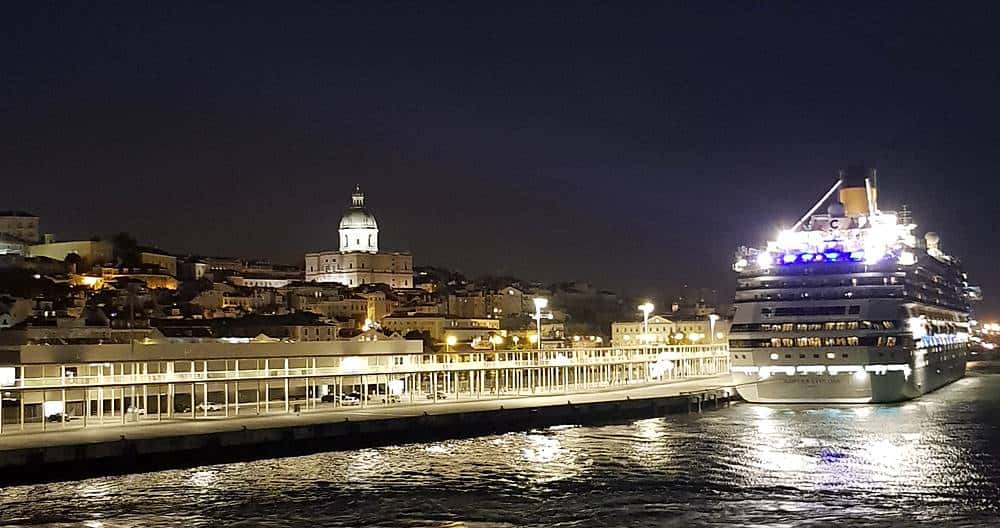
2. Santa Apolónia Cruise Terminal
This cruise terminal is integrated with the New Lisbon Cruise Terminal, and complementary to the main terminal building.
3. Rocha do Conde de Óbidos Cruise Terminal
Rocha do Conde de Óbidos is located near the famous Ponte 25 de Abril bridge, approximately 3.5 km (2.2 miles) from the New Lisbon Cruise Terminal and 2.5 km (1.5 miles) from Commerce Square, Lisbon’s central square.
A 483-meter-long quay features two berths, Rocha Conde de Óbidos and Doca de Alcântara (Doca do Espanhol) that can accommodate up to two smaller vessels simultaneously.
This terminal is normally used during the busy season when the New Lisbon cruise terminal is too crowded. Public toilets, a tourist information center, parking, and taxis are available at this terminal.
Getting Around Port of Lisbon
- Lisbon is a big city and is best explored on foot, however, some parts of the city are hilly and some famous districts such as Belem are located a few miles away from the cruise port, so public transportation can come in handy.
- Lisbon boasts well well-developed public transportation network (bus, tram, metro). You can check the timetables for the metro, tram and bus at https://www.carris.pt/
- Besides being an efficient way to get around the city, Lisbon trams are also a famous tourist attraction due to their historic, authentic look. A modern tram #15 connects Commerce Square and Belém district, and you can catch this tram at Commerce Square, located 10 minutes walk from the New Cruise Terminal. Tram #28 is a unique wooden tram that connects the major historic districts in the heart of Lisbon: the bohemian Bairro Alto neighborhood, Graça, Mouraria, Alfama, Baixa, Chiado, and Madragoa districts. You can catch this tram across the street from the New Cruise Terminal, near Commerce Square ((Rua da Conceição) and the Fado Museum.
- Lisbon metro is the fastest way to get around the city and boasts the status of one of the cleanest metros in Europe. It has four lines (Blue, Yellow, Green, Red), however, it doesn’t run past some of the major city attractions and historic neighborhoods such as Belém. The closest metro station to the New Cruise Terminal is Terreiro do Paço, located across Commerce Square, and there is also one metro station across Santa Apolónia cruise terminal. If you are exploring Lisbon’s highlights and the historic heart of the city, using the tram is recommended.
- Lisbon has a great public bus network. The bus stop is right across the New Cruise Terminal and you can easily catch a bus to the Belém district. However, I don’t recommend the bus if you want to explore the city’s historic core, as Lisbon’s old town is hilly, with many narrow, cobbled streets (where a bus can’t go because of its size). Read more about bus lines at https://www.lisbon.net/bus
- Lisbon taxi is an inexpensive and convenient way to get around the city. They often have a beige color and are metered. Uber is also available in Lisbon.
- There are several Lisbon Hop on Hop off sightseeing bus companies in Lisbon. Open sightseeing bus has three routes (Red, Green and Blue Line) and is a great way to explore the city as it stops at its major landmarks and attractions. Check the Lisbon Hop on Hop off bus tours on Viator and Get Your Guide
- The currency in Portugal is EURO (€). ATMs and currency exchange are available in the terminals and the city. Local currency and credit cards are widely accepted.
- Book a private transfer to/from the port of Lisbon
- Explore Lisbon tours and activities
- Find accommodation near Lisbon port

10 Awesome Things to Do in Lisbon Cruise Port
Before I share the best things to do in Lisbon, I invite you to grab your copy of the “Mediterranean Cruise Port Guide”, the most comprehensive guide to 45 Mediterranean cruise ports (including Lisbon), packed with practical information, expert tips & unforgettable experiences! (PDF format/200 pages)
 A Comprehensive Guide to 45 Mediterranean Cruise Ports
Plan your cruise itinerary in less than an hour and maximize your port experience!
A Comprehensive Guide to 45 Mediterranean Cruise Ports
Plan your cruise itinerary in less than an hour and maximize your port experience!
1. Explore Lisbon by Tuk Tuk
Exploring by tuk-tuk is a great way to visit Lisbon as a large portion of the city is very old, full of narrow cobblestone streets climbing uphill that you can’t visit by bus or by car (and walking uphill can be exhausting).
If you are coming on a cruise ship, you’ll find many local vendors and independent tuk-tuk drivers waiting for you outside the cruise terminal, eager to sell you their tours.
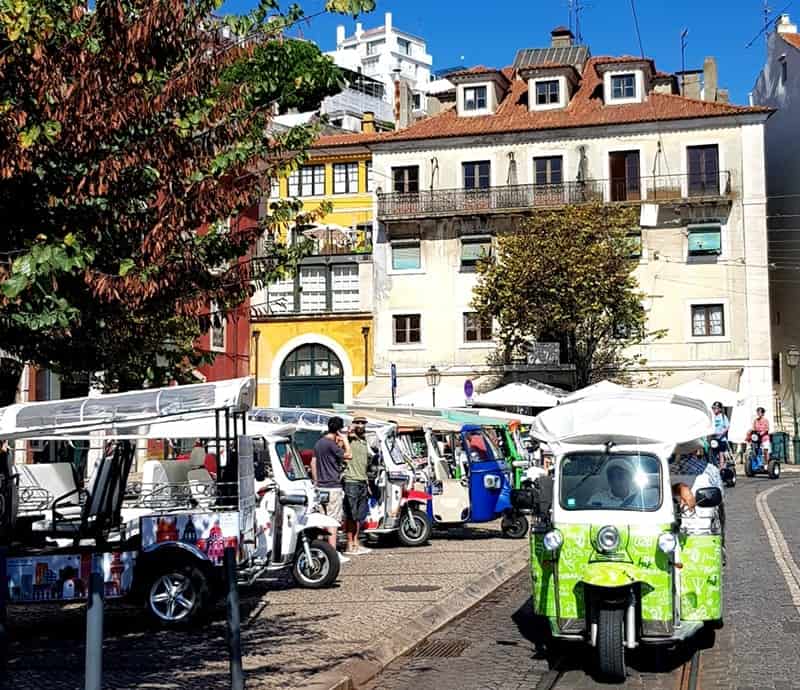
What to visit by Lisbon tuk-tuk
- Miradouro da Graça Viewpoint – This fantastic lookout point is located in Graça District, one of the oldest suburbs of Lisbon situated on top of the city’s highest hill.
- Miradouro da Senhora do Monte (Our Lady of the Hill)
- Miradouro São Pedro de Alcântara
- Rossio Square (Praça do Rossio) – The busiest and most lively area of Lisbon, a favorite meeting spot and home to various monuments and places of interest, such as the Column of Pedro IV (known as “the soldier king”), the 19th century National Theater D. Maria II, Rossio Railway Station, and others. It is surrounded by numerous cafes, bars, and restaurants, and here you can find a good, relatively cheap place to stay as well.
- Belém district – I’ll write more about this renowned historic district below, however, there are three important monuments that you should remember to visit here: Belém Tower, the Monument to the Discoveries and Jerónimos Monastery.
Check out Lisbon tuk-tuk guided tours and activities


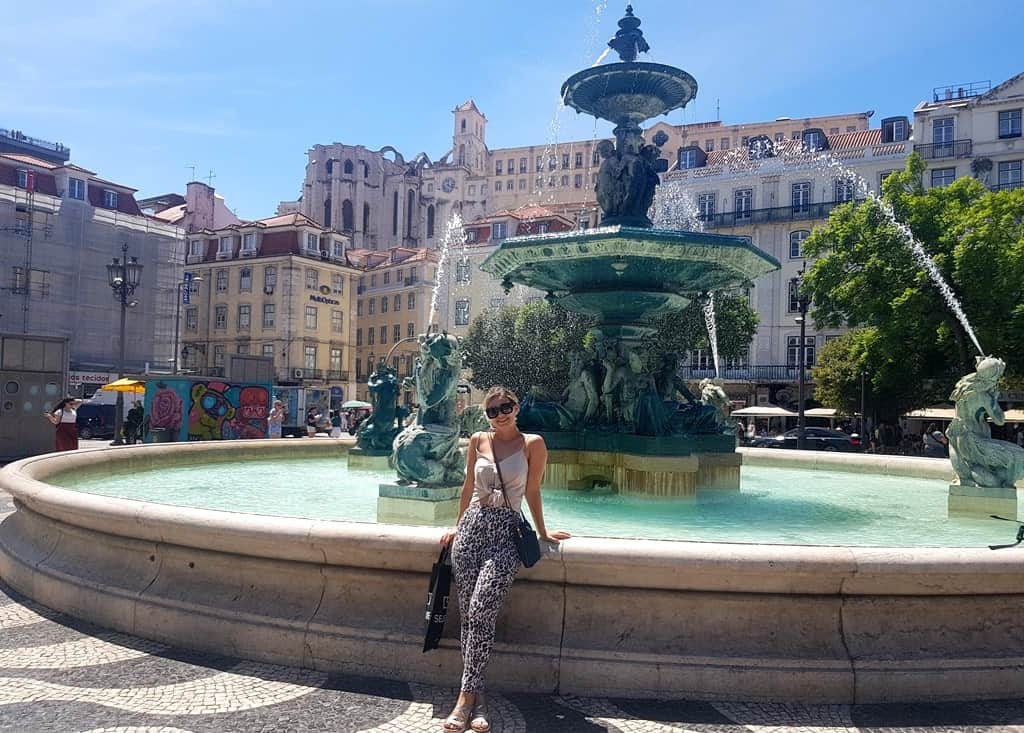
2. Hippotrip Amphibious Bus Ride
Hippotrip amphibious bus ride is by far the most fun way to visit Lisbon! An amphibious vehicle is a sort of bus that can enter into the water as well, so you get a tour of the city both by land and by water in just 2 hours (that’s normally the tour duration).
There are only several amphibious vehicles in Lisbon and the tour is really popular, so if you want to ensure your spot, you should book the tour in advance (cruise lines normally offer this tour, so make sure you pre-book it)!

What to see on an Amphibious bus tour?
- In the land part of the tour, you’ll enjoy a panoramic drive through the historical quarter of Lisbon, passing by the Praça do Comércio (Commerce Square), Rossio Square, and Avenida da Liberdade, before you reach a remarkable historic district of Belém.
- If you book a shore excursion with your cruise ship, the tour usually includes a stop at Belém, where you’ll try famous pasteis de nata, a custard cream pastry crafted from a secret recipe from the Jerónimos monks.
- A tour can also include a stop at Jerónimos Monastery, a UNESCO World Heritage Site, and the burial place of Vasco de Gama.
- After the land portion of the tour, the Hippotrip bus will drive into the Tagus River, and the moment itself is the highlight of the tour! Once on the water, your bus will sail along the river and get close to the iconic Belém Tower, the Monument to the Discoveries, and other landmarks.
Check out HIPPOTRIP amphibious bus tours
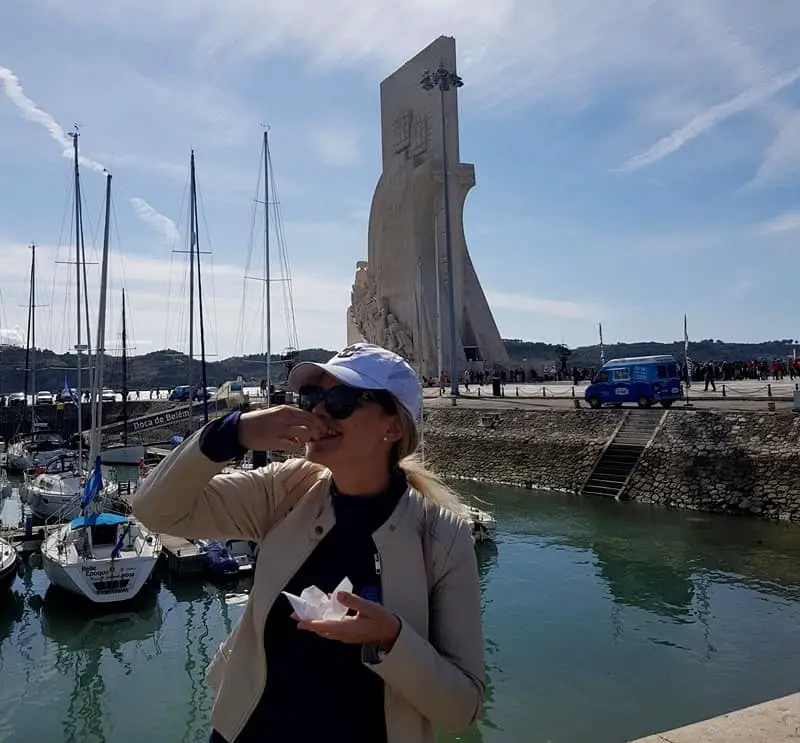
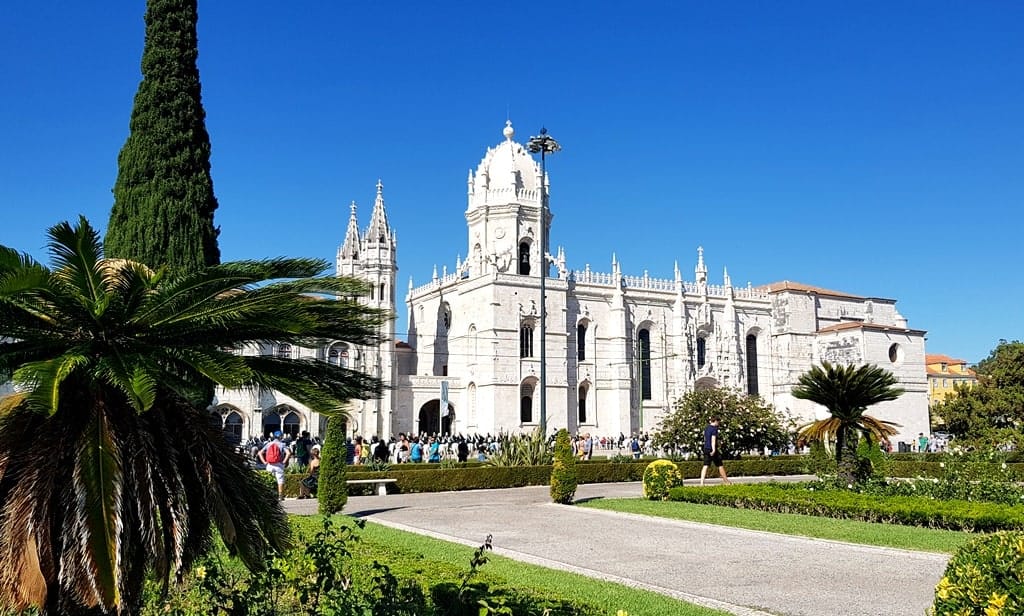
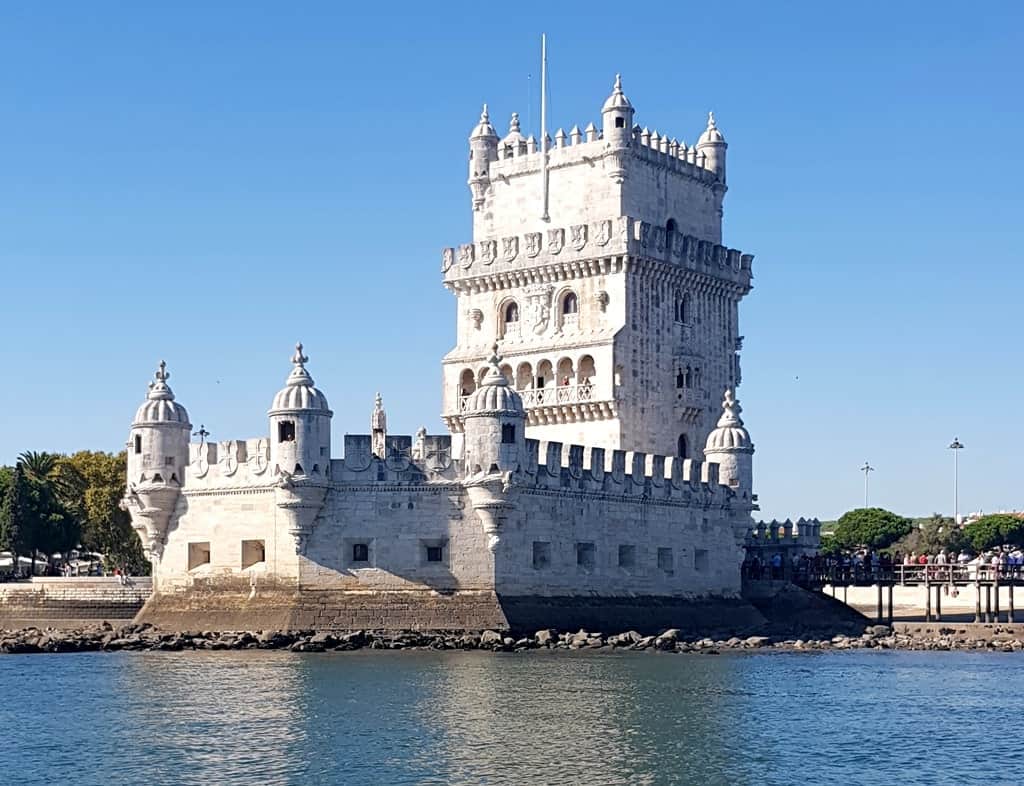
3. Alfama District
If you want to feel the authentic spirit of Lisbon, this is the most unique way to do so! Alfama is the oldest district of Lisbon, situated in the heart of the city, on the slope between São Jorge Castle and the Tagus River.
If you are coming on a cruise ship, your ship will be docked right by the Alfama neighborhood (New Lisbon Cruise Terminal), so you’ll just need to cross the street and start your walk.
In the past, under Moorish domination, Alfama was located outside of the city walls, populated by fishermen and the poor. During the Age of Discovery, it remained the neighborhood of low-class dockworkers and sailors; sailors’ women used to sing melancholic songs when their beloved ones would set sail into the unknown, and that’s how Fado music was born.

Nowadays, Alfama is a colorful labyrinth of narrow streets and alleys, numerous tiny squares, whitewashed houses, and picturesque buildings, which makes Lisbon the city of contrasts.
Once you start climbing up the streets, on every corner, you can smell the taste of traditional local delicacies coming from tiny, authentic cafes, or you can come across beautiful, unexpected viewpoints offering unique views over Lisbon and the Tagus River.
Some major city landmarks are located in Alfama, such as:
- Sé Cathedral (Lisbon Cathedral) – Built in the 12th century, this is the oldest cathedral in Lisbon.
- The Monastery of São Vicente de Fora
- Church of Santa Engrácia (National Pantheon)
- Castelo de São Jorge – One of the symbols of Lisbon dominating the city panorama.
-
Museu do Fado (Fado Museum) – This amazing museum boasts exhibitions on traditional fado, with audiovisual displays and archives.
Check out Alfama district tours and activities

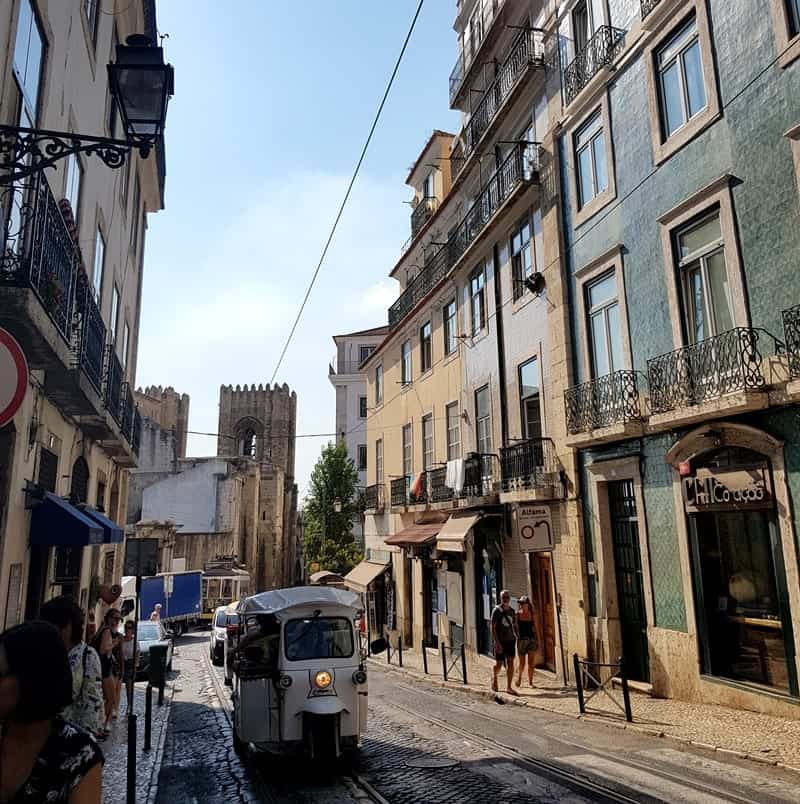
4. Belém District
Belém district is one of Lisbon’s most popular neighborhoods nestled along the Tagus River, filled with green spaces, houses decorated with colorful tiles, important historic landmarks, and numerous seafood restaurants along its beautiful waterfront promenade.
Belém neighborhood is located approximately 8 km/5 miles from the New Lisbon cruise terminal and the best way to get there is via bus, tram, bike, segway, or tuk-tuk. Belém is famous for its three important historic landmarks:
4.1. Belém Tower (Torre de Belém)
Built between 1514 and 1520, this tower’s main function was to defend the city. It was at Belém that many of the great Portuguese explorers embarked on their overseas journey, as it was the main location of Lisbon’s docks and shipyards back in time.
Belém Tower was declared a UNESCO World Heritage and the visits inside the tower are open to the public.
4.2. Monument to the Discoveries (Padrão dos Descobrimentos)
The monument is located along the northern bank of the Tagus River, a 10-minute walk from Belém Tower. The monument is an impressive 52-meter tall structure, built in 1940 to commemorate the 500 years since the death of Henry the Navigator, who discovered the Azores, Madeira, and Cape Verde.
4.3. Jerónimos Monastery (Mosteiro dos Jerónimos)
This impressive monastery is a UNESCO World Heritage Site and one of the most important religious structures in Lisbon. The western wing of the Jerónimos Monastery along with the main visitors’ entrance is home to the Maritime Museum, dedicated to the history of navigation in Portugal, definitely worth visiting while you are there.
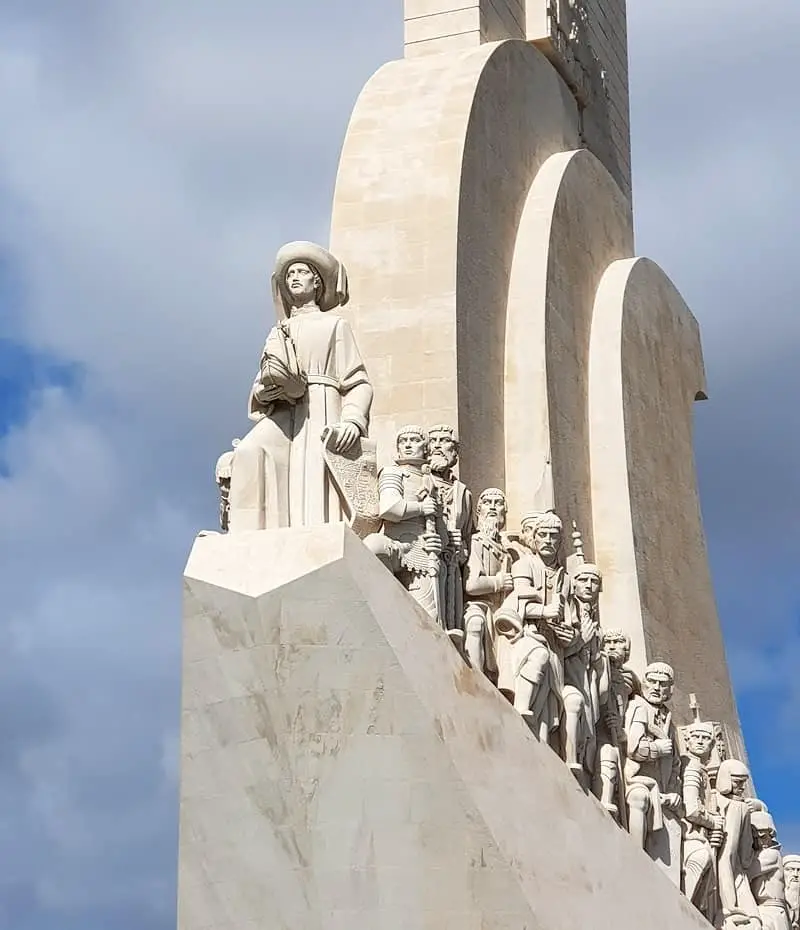


All three monuments – Belém Tower, the Jerónimos Monastery, and the Monument of the Discoveries are located within a 10-15 minute walk from each other.
In Belém district, you can also visit botanical gardens and traditional Portuguese markets, or relax at one of the cafes, bars, and restaurants along the Tagus River.
If you are looking for a unique and unconventional way to visit Belém, it is great to do it by segway, bike, or tuk-tuk.
Check out Belém district tours and activities
5. Baixa Neighborhood (Commerce Square, Rua Augusta)
The Baixa (“Downtown”) is another popular historic neighborhood in Lisbon, located next to the Alfama district. Lisbon’s downtown area and some major city attractions are part of the Baixa neighborhood:
- Commerce Square (Praça do Comércio) – One of the main squares of the city which historically served as the main trading place, as the southern end of the square is open to the Tagus River. The square is huge and in the middle of it proudly stands out the bronze Equestrian statue of Joseph I – the king of Portugal in the 18th century.
- Rua Augusta Arch – Another place of interest on the square is the famous Rua Augusta Arch, which marks the entrance to the main pedestrian street of Lisbon – Rua Augusta. The triumphal arch symbolizes the resurrection of Lisbon and features the statues of important historical figures such as Vasco de Gama and the Marquis de Pombal on the top of its pillars.
- Rua Augusta – The main pedestrian street of Lisbon where you’ll find many restaurants, pastry shops, and branded stores.
- Rossio Square – This huge square is located at the end of Rua Augusta and is easily identified by the imposing Column of Pedro IV and the D. Maria II National Theatre.
- Figueira Square (Praça da Figueira) – This large square is parallel to Rossio Square and is dominated by the Equestrian statue of King John I.
- Avenida da Liberdade – A notable tree-lined boulevard, known as one of the most expensive streets in Lisbon.
Lisbon cruise terminal is located only a 10-15 minute walk from Commerce Square. You can reach it if you follow a beautiful waterfront promenade that is more than 9 kilometers long.

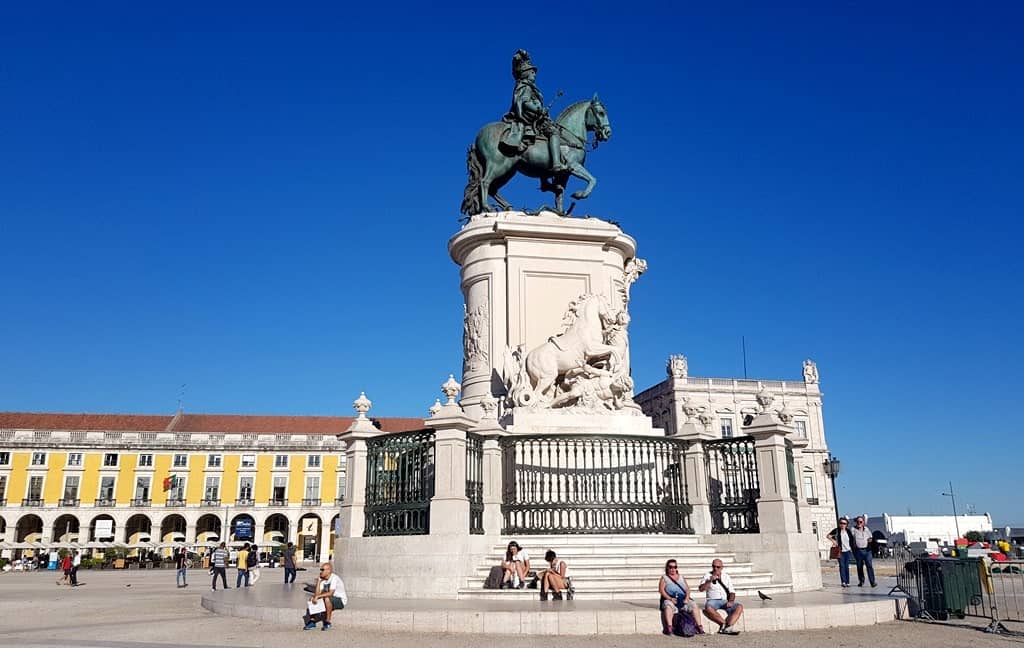
If you keep walking along the promenade, in a 1.5-hour walk you’ll reach the Belém neighborhood and the striking 25th April Bridge, one of the symbols of Lisbon and the longest suspension bridge in Europe.
The bridge is impressive at all times of the day; I managed to see it at dawn, during the day, in the evening, and at night, and in my opinion, the best time to enjoy the view is at sunset.
Check out Lisbon walking tours and activities

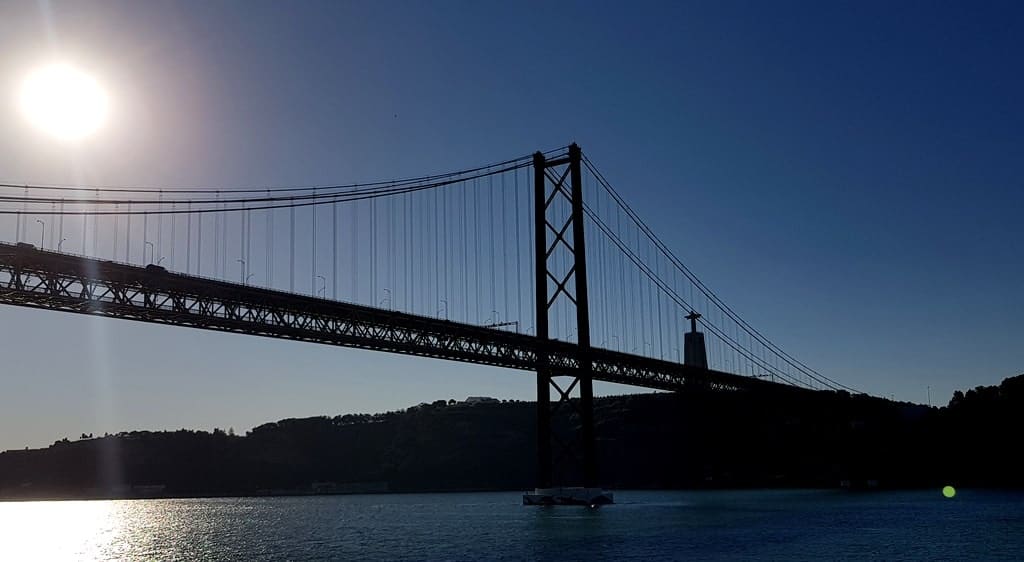
6. Taste the Original Pastel de Nata
Pastel de nata is a delicious pastry with custard dusted with cinnamon. The creation of pastéis de nata is associated with Catholic monks of the Jerónimos Monastery who created the recipe in the 18th century.
Only a handful of people know the original recipe of pastel de nata and an interesting fact is that the recipe has never been written down.
Nowadays, pastéis de nata have been produced worldwide but the original recipe is being kept in secret: the original ones are produced by the Pastéis de Belém pastry factory in Lisbon, and one of the places where you can try them is Café Pastéis de Belém (Rua de Belém nº 84 a 92). I tried them, and they are super delicious!
Check out Lisbon food tours and activities
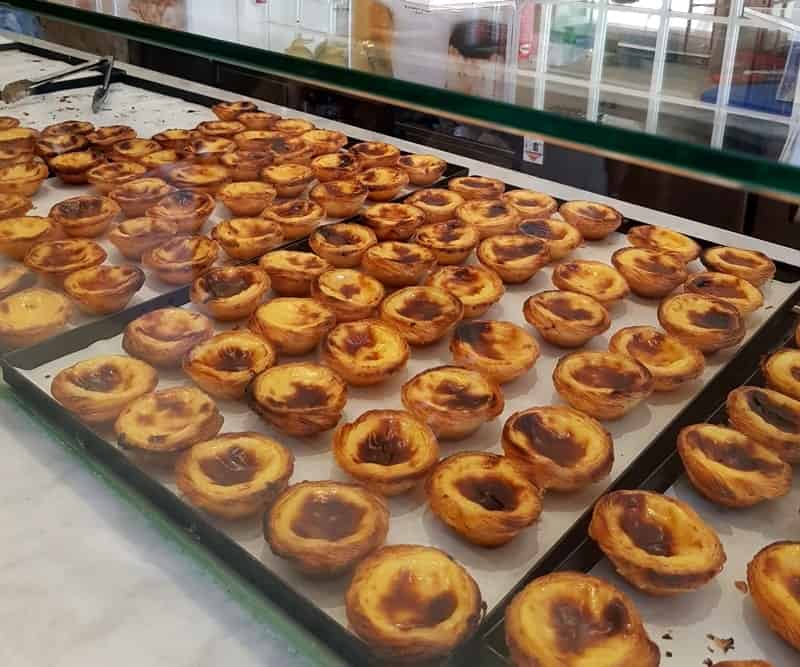
7. Lisbon Wine Tasting
Lisbon is also famous for its great wines produced in the wine region located west and north of the city, known as Estremadura. Throughout the centuries, many families have preserved the tradition of wine-making and many of them offer wine-tasting tours followed by a visit to the wine cellars.
You can try Portuguese wines anywhere, but I recommend you taste them in authentic places with a long wine-making tradition (those places are usually family businesses over a century old), such as the one in the picture below.
I would also recommend you pair wines with Bolinhos de bacalhau, tasty codfish cakes, the most popular appetizer in Portuguese cuisine.
Explore Lisbon wine-tasting tours and activities

8. Day Trip to Sintra and Cascais
One of the most popular day trips from Lisbon offered by both cruise lines and independent tour operators is a visit to the charming town of Sintra, located 39 km/25 miles (a 40-minute drive) northwest of Lisbon.
Sintra is a picturesque town and municipality best known for its magnificent colorful palaces, castles, parks, gardens, and scenic beaches.
Due to its historical significance and outstanding beauty, Sintra has been declared a UNESCO World Heritage Site. Some of the must-see Sintra highlights are:
- The Palácio Nacional da Pena – A Romanticist castle known for its opulent yellow and red facade.
- Palácio Nacional de Sintra – Known as the Town Palace, this is one of the best-preserved medieval royal residences in Portugal dating from the 15th century.
- Castelo dos Mouros – The Castle of the Moors, a hilltop medieval castle.
- Monserrate Palace – A 19th-century mansion inspired by Moorish, Gothic and Indian influences, set in the middle of lush botanical gardens.
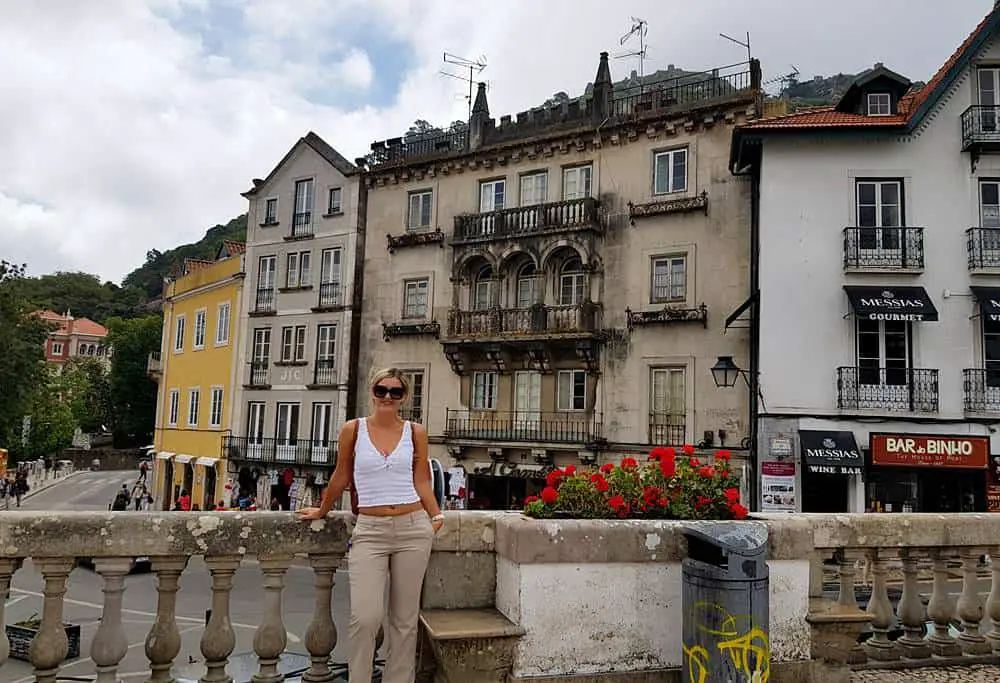
Day trips from Lisbon usually take half a day due to the ship’s limited time in port. These tours are guided, and guests normally get some free time as well.
Many tours include a stop at Cascais, an upscale holiday destination located 17 km/10.5 miles (a 20-minute drive) south of Sintra, on Lisbon seaside.
Cascais is known for its lavish villas, imposing fort, museums, and cobbled streets filled with lively bars and restaurants. Its golden sand beach is perfect for swimming, sunbathing and relaxing. Cascais is a perfect surf and yoga retreat if you prefer to escape and relax from the bustling city life.
You can get to Sintra and Cascais by train or bus from Lisbon, however, due to the distance and limited time in port, the best way to visit it is on a guided shore excursion.
Check out Sintra and Cascais tours and activities

9. Fátima Religious Site
Located 128 km/80 miles (a 1-hour 30-minute drive) north of the port of Lisbon, Fátima is one of the Christian religion’s most significant pilgrimage sites. This site has been associated with the permanent apparitions of the Virgin Mary ((Our Lady of Fátima), the mother of Jesus, witnessed by three local shepherd children in 1917.
Nowadays, visitors can visit the Sanctuary of Our Lady of Fátima, a complex of religious buildings and basilicas that draws millions of religious people annually who come to pay homage to the shrine.
Check out Fatima tours from Lisbon

10. Day Trip to Óbidos
Located 90 km/56 miles (a 1h 10-minute drive) north of the port of Lisbon, Óbidos ranks among the best-preserved medieval villages and walled towns in Europe.
Strategically built on a hilltop near the Atlantic Ocean, the village still preserves the authentic spirit of old times with a maze of narrow streets, whitewashed houses, quaint squares, and Gothic architecture.

Make sure you visit Porta da Vila (the town gate) with its beautiful blue and white tile panels; Rua Direita, the main street lined with shops, bars, restaurants and small galleries; Praça de Santa Maria, the town’s main square; Castelo de Óbidos, an imposing castle originally dating from the 9th century; Igreja de Santa Maria, the town’s main church; Aqueduto de Óbidos, the 16th-century aqueduct.
You can shop for traditional handicrafts and taste the Ginjinha (ginja de Óbidos), a famous Portuguese liqueur made from sour cherries. Some tours going to Óbidos also include a visit to Fátima religious site and Nazaré, a popular seaside resort on the Atlantic coast.
Check out Óbidos tours from Lisbon
Visit our cruise port guides for Barcelona, Palma de Mallorca, Ibiza, Villefranche (Monaco), Marseille, Santa Cruz de la Palma, Las Palmas (Gran Canaria), Rome (Civitavecchia)
You may also like our cruise port guides to the Mediterranean, Caribbean, Western Europe, Baltic & Scandinavia, USA & Canada, Australia & New Zealand
Don’t miss out on the opportunity to enhance your Mediterranean cruise experience with our “Mediterranean Cruise Port Guide“- your ultimate companion to discovering the region’s hidden treasures and creating unforgettable memories; click below to purchase your copy today and embark on the voyage of a lifetime!

Ultimate Guide to Mediterranean Cruise Ports
Plan your Cruise Itinerary in Less than an Hour and Maximize Your Port
Experience!
This article may contain affiliate / compensated links. For full information, please see my disclaimer here.





